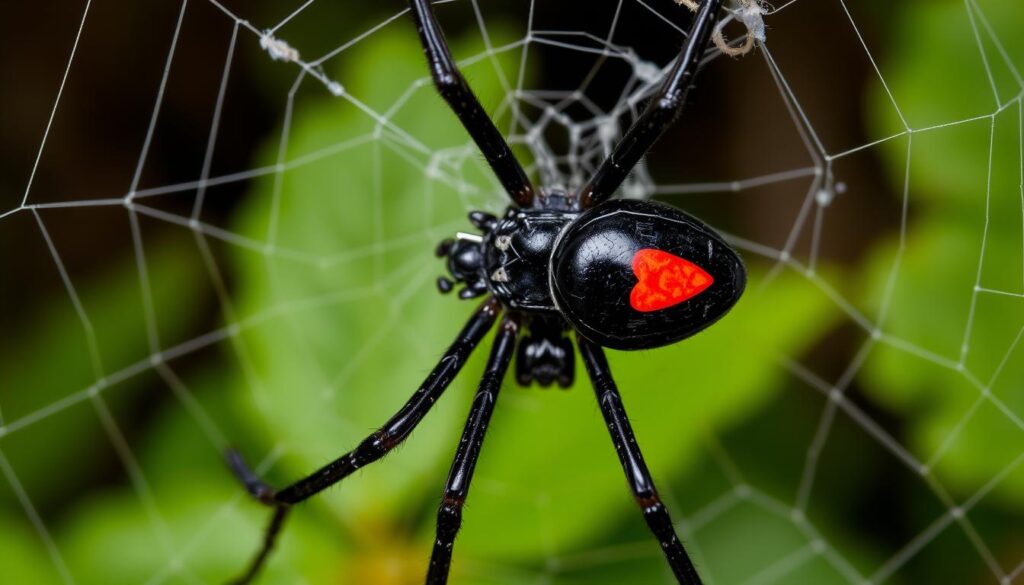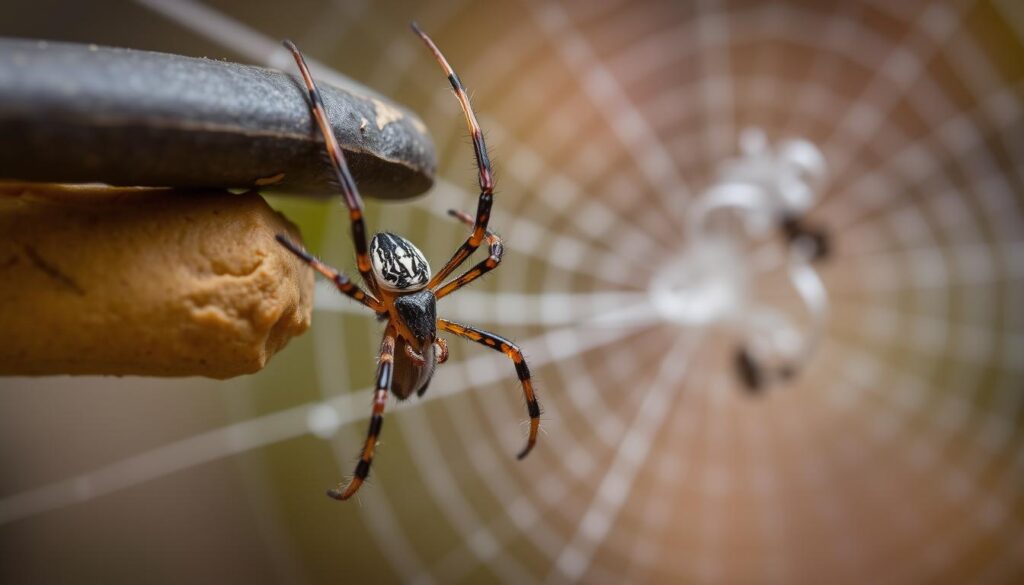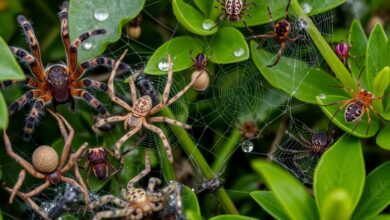How Big Is a Black Widow Spider? Size Guide

Black widow spiders are known for their strong venom and unique look. But did you know their size can change a lot? They vary in body length and leg span. Knowing their typical size is important, whether you’re interested in them or want to stay safe.
This guide will cover the size of these venomous spiders. We’ll look at what affects their growth and how they compare to other spiders.
By the end of this article, you’ll know more about black widow spiders. You’ll learn about their distinctive hourglass markings and leg span. This knowledge will help you identify and appreciate these spiders safely.
What Is a Black Widow Spider?
The black widow spider, known as Latrodectus mactans, is found in North and South America. They have shiny black bodies and a red hourglass on their belly. These spiders belong to the Theridiidae family and have venom that can harm humans.
Identifying the Venomous Latrodectus Mactans
It’s important to know how to spot a Latrodectus mactans to stay safe. Black widow spiders have unique features:
- Glossy, jet-black bodies with a round, bulbous abdomen
- Bright red hourglass-shaped marking on the underside of their abdomen
- Long, slender legs that can span up to 3 inches in length
- Relatively small size, typically ranging from 1/2 to 1 1/2 inches in body length
Learning about the black widow’s features helps you avoid them. This way, you can avoid their venomous spider characteristics and dangerous spider markings.

How Big Is a Black Widow Spider?
Black widow spiders come in various sizes. A full-grown black widow is usually 1.5 to 3.5 inches (3.8 to 8.9 cm) long, including their legs. Without their legs, their body is about 0.5 to 1.5 inches (1.3 to 3.8 cm) long. This range helps us understand the typical black widow spider size.
These spiders are known for their black bodies and bright red hourglass mark. Their size can change based on their gender, age, and where they live. Knowing the average black widow spider size is key for spotting and staying safe.
| Measurement | Typical Range |
|---|---|
| Total Length (including legs) | 1.5 to 3.5 inches (3.8 to 8.9 cm) |
| Body Length (excluding legs) | 0.5 to 1.5 inches (1.3 to 3.8 cm) |

Knowing the average black widow dimensions helps you spot these venomous spiders and stay safe. Whether you love the outdoors or just find these spiders interesting, learning about their size is a great way to appreciate nature.
Black Widow Spider Size Compared to Other Species
It’s key to know how black widow spiders compare in size to others. They are medium-sized, but their size can vary a lot. This is compared to both larger and smaller spiders found in nature.
Widow Spider Body Length and Legspan
Black widow spiders usually have bodies that are 0.5 to 1.5 inches long. Their legs can stretch up to 3.5 inches, making them look bigger than they are. In contrast, some big spiders like Huntsman and Tarantulas can be 2 to 5 inches long and have legs up to 12 inches long.
The smallest spider, the Patu digua, is tiny. It’s only 0.37 to 0.39 millimeters long and has legs about 1 millimeter long. Knowing these sizes helps us understand the dimensions of various spider types and their danger to humans.
| Spider Species | Body Length | Legspan |
|---|---|---|
| Black Widow | 0.5 to 1.5 inches (1.3 to 3.8 cm) | Up to 3.5 inches (8.9 cm) |
| Huntsman Spider | 2 to 5 inches (5 to 13 cm) | 6 to 12 inches (15 to 30 cm) |
| Tarantula | 2 to 5 inches (5 to 13 cm) | 6 to 12 inches (15 to 30 cm) |
| Patu digua | 0.37 to 0.39 mm (0.015 to 0.016 inches) | Around 1 mm (0.04 inches) |
Knowing the relative spider dimensions helps us understand the risks. It also helps us know how to act when we see these spiders.
Factors Influencing Black Widow Spider Size
Several factors can affect a black widow spider’s size. These include its age, gender, and the environment it lives in. Younger spiders are usually smaller, while older ones are bigger. Also, female black widows are often larger than males.
Things like food, temperature, and humidity also matter. Spiders in areas with plenty of food, the right temperature, and humidity grow bigger. Knowing what affects their size helps us understand them better.
- Age: Younger black widows are generally smaller, while mature adults reach the larger end of the size range.
- Gender: Female black widows are typically larger than their male counterparts.
- Food availability: Access to a steady supply of prey can contribute to the overall size of black widows.
- Temperature: Ambient temperature can influence the growth and development of black widows.
- Humidity: Suitable humidity levels are important for the thriving of black widow spiders.
By looking at these factors, we can understand more about black widow size. This helps us see how the environment and other variables affect their size.
Geographical Range and Habitat
Black widow spiders are found in North America, from Canada to Central America. They live in places like woodpiles, sheds, and garages. These areas are dark and secluded. Some places have more black widows than others.
Regions Where Large Black Widows Are Found
In the Southwestern United States, especially California and Arizona, you’ll find big black widows. Climate, food, and human activity affect how big they get in certain spots.
| Region | Average Black Widow Size |
|---|---|
| Southwestern United States | Larger than average |
| Other Parts of North America | Smaller in size |
The Southwestern United States is warm and has lots of food. This makes it perfect for big black widow spiders. In other parts of North America, they are smaller because of different environments and food.
Knowing where black widow spiders live and what they like can help keep you safe. If you know where big ones are, you can be more careful. This way, you can avoid them and watch for any bites.
Dangerous Spider Measurements: A Safety Guide
Size is a big deal when it comes to black widow spiders. These venomous arachnids can be a big threat, especially the bigger ones. Knowing how big a black widow spider is helps keep you safe and take the right steps.
The size of a black widow spider affects how bad its bite can be. Bigger spiders have bigger fangs, which means they can inject more venom. This venom can cause serious symptoms like muscle pain, nausea, and breathing problems. In rare cases, it can even be deadly.
- Black widows can range in body length from 1/2 inch to 1 1/2 inches, with a legspan that can exceed 3 inches.
- The females are typically larger than the males, with a more pronounced hourglass marking on their abdomen.
- Geographical factors and environmental conditions can influence the size of black widow spiders, with some regions known to produce larger specimens.
To avoid dangerous encounters with black widow spiders, take the right precautions. Don’t touch these spiders, even if they seem small. Keep your living and work areas clean to discourage them. By knowing the dangerous spider dimensions and taking safety steps, you can lower the risk of harm from these venomous arachnids.
Black Widow Physical Characteristics and Markings
Black widow spiders are known for their size and unique features. Their shiny, jet-black bodies are the perfect background for their famous red hourglass-shaped marking on their abdomen. The size and shape of this hourglass can vary, making each spider unique.
These spiders also come in different color variations of their hourglass markings. Some have a reddish-orange or yellow-orange hourglass. These differences help in identifying and recognizing these venomous arachnids.
Hourglass Spider Size Range and Color Variations
The size of the hourglass spider varies. Some have a smaller, more defined hourglass, while others have a larger, more diffuse one. This size variation is just one of the many interesting things about these spiders.
Black widows also show a range of color variations in their markings. They can have a classic red hourglass or variations like reddish-orange and yellow-orange. This diversity shows how adaptable and unique this species is.
| Physical Trait | Description |
|---|---|
| Body Color | Shiny, jet-black |
| Hourglass Marking | Characteristic red hourglass shape, varying in size and intensity |
| Color Variations | Reddish-orange, yellow-orange hourglass patterns |
Venomous Spider Dimensions: Bite Precautions
The size of a black widow spider matters when thinking about bite risks. Black widows are not usually aggressive, but their venom is very potent. This can be dangerous, especially for larger spiders.
The size of their fangs and venom depends on their dimensions. Bigger black widows can bite harder. This might lead to more serious symptoms and needing quick medical help.
When dealing with black widow bites, size is a big concern. The bigger the spider, the more dangerous the bite. It’s important to stay cautious and keep a safe distance from them. Knowing how to handle venomous spider encounters can help keep you and your family safe.
Black widow spiders are common in many parts of the U.S. and can vary in size. Knowing the dangers and how to avoid bites is key to staying safe. If you think you’ve been bitten, get medical help right away. This ensures you get the right treatment and avoid serious problems.



